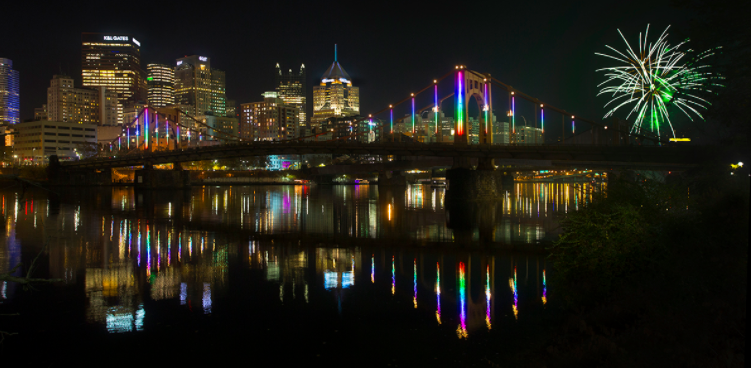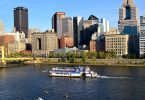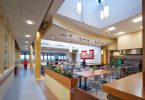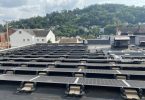Pittsburgh’s environmental innovations run through every fabric of our society, at the confluence of art and the built environment, and with inspiration from our industrial past to our green-focused present and future. The following are some artists driving Pittsburgh’s environmentally-focused art and challenging our residents to see the city in a new way.
Andrea Polli, Professor of Art & Ecology, the University of New Mexico
Andrea Polli’s current work Energy Flow helps city residents track environmental changes through a light display on the Rachel Carson bridge over Pittsburgh’s Allegheny River. The project is funded by Riverlife, and hopes to bring normally-unseen changes in the wind to life for Pittsburghers. Ron Gdovic of WindStax, a Pittsburgh-based wind turbine manufacturer, collaborated with Polli to bring the exhibit to life.
As Riverlife describes, over 27,000 multicolored LED lights positioned along the bridge’s vertical cables show a real-time visualization of wind speed and direction as captured by a weather station located on the bridge. The electricity needed to power Energy Flow is generated by sixteen wind turbines attached to the catenary arches of the bridge. Rachel Carson, for whom the bridge is named, was a revolutionary environmentalist who made issues of pesticide and pollution more prominent in American culture. Like Carson, Polli is helping take wind patterns and transform transform them into something Pittsburgh can see, begin to understand, and track.

Energy Flow, by Larry Rippel for Riverlife

Energy Flow, by Larry Rippel for Riverlife

Energy Flow, by Larry Rippel for Riverlife
Contact:
Andrea Polli, apolli@unm.edu
Stacy Levy:
Stacy Levy’s newest work at the Frick Environmental Center, Rain Ravine, contributes to the Water and Beauty elements of the building’s overall Living Building Challenge. Rain Ravine carries all the rain from the building’s roof to the wetlands for reuse as part of the required net zero waste on the site. All the rain water from the roof flows through the sculpture, which consists of a series of ever-deepening stone runnels that evoke the shale geology in the park. The topographical stone runnel highlights the movement of water in wet weather and in dry weather, reflects the power of water’s eroding force.

Rain Ravine, courtesy of Stacy Levy
Rain Ravine helps with the Frick Environmental Center’s mission by collecting and conveying all runoff water on the site, fulfilling two of the eight requirements of the Living Building Challenge: for net zero water flow and for beauty. Rain Ravine also has an educational role: it attracts visitors to come to witness the flow of rainwater, and to play in this water as it rushes past the building. In its dry state, the artwork creates a visual metaphor of the terraced shale geology of the Ravine, giving people a vivid image of the geologic patterns to seek out as they explore more deeply into Frick Park.
Rain Ravine was a collaboration with the building architects Bohlin Cywinski Jackson and the landscape architects La Quatra Bonci, to convey the rain water through the site in a way that is both functional and evocative. The artist also collaborated with the education department of the Pittsburgh Conservancy. One of the goals of the artwork was to create a visceral sense of the quantity of rain that falls in this biome. The artwork is truly a collaboration between the built environment and the local weather.

Rain Ravine, courtesy of Stacy Levy

Rain Ravine, courtesy of Stacy Levy

Rain Ravine at the Frick Environmental Center, courtesy of Stacy Levy
Contact:
Stacy Levy
814-360-4346
stacy@stacylevy.com






